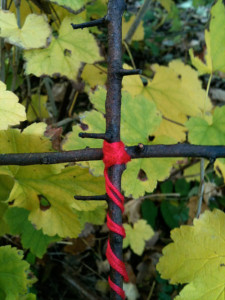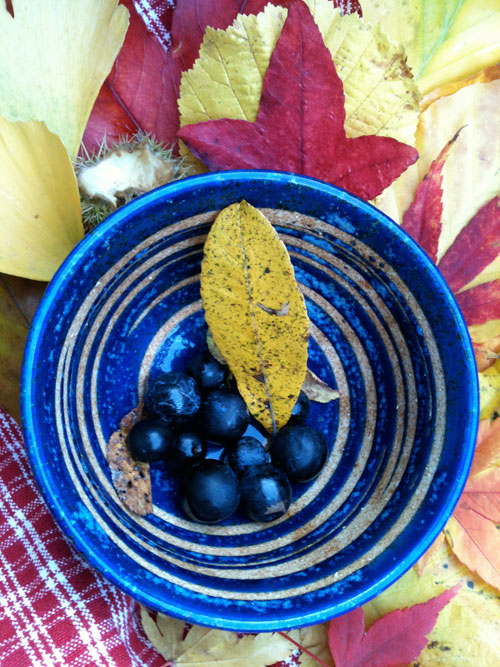
Since childhood I’ve often struggled with Remembrance Sunday. When I was growing up much of the culture around me was still unconsciously immersed in a rather Victorian Christianity, with an imperialist quality which horrified me. Not that I didn’t and don’t deeply feel for all who suffer through warfare but I am a pacifist at heart. Also, as someone who has survived a war zone and still wakes up sometimes from nightmares and flashbacks, this can be quite a haunted day. So what better way to move into Remembrance Sunday today than in the good company of Wild Church.
When I was preparing for our slow, sloe remembrance pilgrimage during the week, I spent about an hour sitting silently in a blackthorn thicket in the pouring rain. Contrary to what you might imagine, it was a magical time full of fascinating fungi and accompanied by a tiny gold crest who was also sheltering among the sloes. But I was concerned that other members of Wild Church might not share my love of an all weather approach, so it was a great blessing to have a beautiful warm and sunny autumn day today.
At 11am we shared a few minutes silence by the dead tree beside the Dartington playing field, while the local football teams played on beside us, our silence concluding just as a goal was scored to wild enthusiasm. Unusually our group today was all women and several of us spoke afterwards in appreciation of the active masculine energy being joyfully channelled into football alongside our reflective feminine gathering.
We started with some thoughts from Llewelyn Vaughan-Lee, editor of the book Spiritual Ecology, to gather us around today’s theme of forgetfulness & remembrance:
“The world is not a problem to be solved; it is a living being to which we belong. The world is part of our own self and we are a part of its suffering wholeness. Until we go to the root of our image of separateness, there can be no healing. And the deepest part of our separation from creation lies in our forgetfulness of its sacred nature, which is also our own sacred nature.”
Then the work & play of remembering sacred nature began! We walked on, along first the outer side and then the inner side of the main Bidwell Brook thicket. Time spent in silent wandering & wondering yielded some collaborative wisdom about the blackthorn/sloe from our own experience. Most of us were struck by the thicket’s prickly and protective edge, where a tangle of spiny older branches and new shoots faced the sun with their gold autumn leaves and a few sloe fruits. Stepping into the shadows at the back of the thicket revealed a more open lattice of black, bare trunks and many dead branches & leaves – a rich ground for lichen, moss & fungi. Some of us found our own nesting spaces within the thicket, while others noticed the impenetrable areas that hold a sanctuary space where only the truly wild creatures can go… burrows, nutshells & droppings revealed that rabbits, mice and birds were regular members of this blackthorn community.
Coming into communion and community also stirred personal memories for several of us, from a farmer’s struggle managing blackthorn hedges and a gardener’s experience of cutting back blackthorn to have multiple suckers spring up like dragon’s teeth, to happy memories of making sloe gin with a grandparent.Both outwardly and inwardly there was a surprising amount of life to be met in the blackthorn thicket.

From here we walked on in silent pilgrimage across the Dartington Estate, discovering young and old blackthorns along the way. I was moved by the sounds of community that are revealed when we don’t talk. The rhythmic tread of feet through the autumn leaves, the voice of the wind in branches.. until we arrived with our second blackthorn community. How different this one seemed in a more sheltered spot, with taller trees where the thrushes were busy with the dark fruits. In a sunny spot with the thicket protective behind us, we created our altar of autumn leaves and passed a bowl of sloe gin around our circle. It’s been a tough year for the sloe fruits due to weather & disease, so it was a particular kind of remembering to taste the richness of last’s year’s sloe harvest. This year I’ve gathered very few fruits as other creatures need them more, so there will be just a half bottle of sloe gin for next year’s communions.
Coming to the end of our pilgrimage I felt that together we had remembered something of our own sacred nature and had a taste of the deeper sacredness of all nature of which we are a part. Having started the day feeling myself a little lonely and lost in the shadows of war, through the practice of remembering I ended up feeling held in the warmth of human and more than human community with a deep sense of peace.
